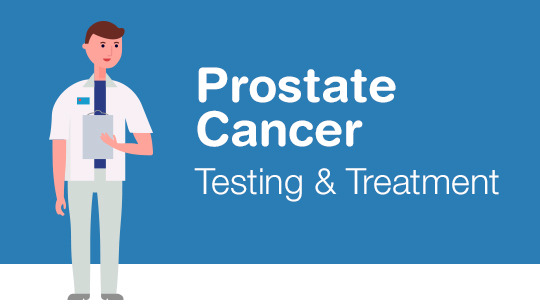
Prostate cancer is the most common cancer after
skin cance and the second leading cause
of cancer-related death among men in the United States.1
It is estimated that 1 in 5 men will be
diagnosed with the disease.2. Prostate cancer is serious, however
most men who are diagnosed do not die from the disease.2 The 5-year
survival rate for prostate cancer is 98.9%3.
The prostate is a part of the male
reproductive system. It is a walnut-sized gland located just below the bladder
in front of the rectum, and surrounds the urethra, which empties urine from the
bladder2, 4. It produces a fluid that that protects sperm cells and
makes up semen4, 5. As a man ages, the prostate tends to increase in
size, which can put pressure on the urethra and slow urine flow2, 4.
Prostate cancer can cause men to urinate more
often or have a weak or interrupted flow of urine, but these symptoms can also
be caused by other non-cancerous prostate conditions.4, 6 Other
symptoms may include pain during urination; blood in the urine or semen;
recurring pain in the back, hips, or pelvis and painful ejaculation.6
Your health professional may screen for
prostate cancer in a few ways. One is through a digital rectal exam (DRE), where a doctor or nurse manually
feels for lumps or other changes to the prostate through the rectum2.
Another is a prostate specific antigen (PSA) test, which measures the blood
level of PSA, a substance made by the prostate.2 High levels of PSA
can occur in men who have prostate cancer.2 If any of these
test results are not normal, doctors may do more tests, such as a biopsy, in
which a tissue sample is taken from the prostate, to find or diagnose prostate
cancer.2 Talk to your doctor to determine the best screening option
for you.
Prostate cancer is highly treatable and rates
of illness and death have decreased over the past few decades.1, 2 This
is due to ongoing advances in treatment and a variety of available treatment
options. Some common treatments include:
- Active surveillance: A close monitoring of prostate cancer progress where patients receive digital rectal exams (DRE) and prostate specific antigen (PSA) tests regularly and move to treat the cancer only if it grows or symptoms change.7
- Surgery: The surgical removal of the prostate in a procedure known as a prostatectomy.7
- Radiation therapy: A treatment that uses high-energy rays (similar to X-rays) to kill cancer cells.7
- Hormone therapy: A treatment that removes or blocks hormones and stops cancer cells from growing.7
If you have any symptoms that concern you, do
not ignore them. See your doctor as soon as possible. Your doctor can perform
screening, provide more information about your risks and help you decide which
treatment option is best.
By Nyahne
Bergeron, MPH
Medical Review Analyst, Clinical Programs and
Quality
References
- National Cancer Institute. A snapshot of prostate cancer. 2014. Available from http://www.cancer.gov/research/progress/snapshots/prostate
- National Cancer Institute. General information about prostate cancer. PDQ® Prostate Cancer Treatment. 2016. Available from http://www.cancer.gov/types/prostate/patient/prostate-treatment-pdq.
- National Cancer Institute. SEER stat fact sheets: Prostate cancer. Surveillance, Epidemiology and End Results Program. 2016. Available from https://seer.cancer.gov/statfacts/html/prost.html
- Centers for Disease Control and Prevention. What is prostate cancer? 2015. Available from https://www.cdc.gov/cancer/prostate/basic_info/what-is-prostate-cancer.htm
- PubMed Health. How does the prostate work? National Library of Medicine. 2016. Available from https://www.ncbi.nlm.nih.gov/pubmedhealth/PMH0072475/
- Centers for Disease Control and Prevention. What are the symptoms of prostate cancer? 2013. Available from https://www.cdc.gov/cancer/prostate/basic_info/symptoms.htm
- National Cancer Institute. Treatment option overview. PDQ® Prostate Cancer Treatment. 2016. Available from https://www.cancer.gov/types/prostate/patient/prostate-treatment-pdq#section/_142


